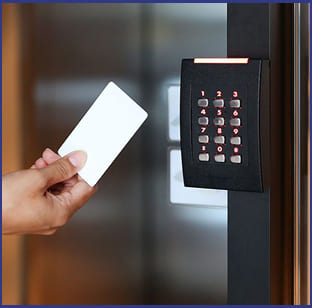About Biometric Access Control System
Biometric Access Control is a system that holds the door for intruders and prevents them from accessing the resources by verifying them as unauthorized persons on the basis of biometrics authentication. In Biometric Access Control system, biometric authentication refers to the recognition of human beings by their physical uniqueness.
Biometric Access Control system works on substantiation. Biometric Access Control system scans the person and matches his/her biometric data with the previously stored information in the database before he/she can access the secured zone or resources. If the compared information matches, the Biometric Access Control system allows the person to access the resources. Today, Biometric Access Control system is considered to be the best and one of the most secured authentication systems amongst the other access control devices.
The solution is access control, which can range from code and card systems to biometric access and facial recognition – the latter is more costly but also more advanced and better for high security areas.
Here are the 5 major benefits of having access control systems installed:
1. It will save you time and money – staff hours can be monitored creating a more productive environment and eliminating false overtime.
2. Link it to payroll - biometric access control as well as “Time and Attendance” systems can be linked to your payroll allowing for accurate and streamlined billing.
3. It provides more control and all-round security - access control can be integrated into your CCTV and security automation system.
4. It protects high security areas – biometric and facial recognition systems especially offer uncompromising protection which requires identification via finger prints, eye retina scans, hand prints and other physical features.
5. It controls the flow of traffic throughout the building – this means you have more control over where your employees or visitors are at any given time and also restricts people to certain areas.
Pros and Cons Biometric Access Control System
Pros of Biometric Access Control System
1. Enhanced Security: Biometric systems provide a high level of security as they rely on unique physiological or behavioral characteristics.
2. Uniqueness: Biometric traits such as fingerprints, iris patterns, or facial features are unique to each individual, reducing the risk of unauthorized access.
3. Reduced Fraud: Since biometric data is difficult to replicate, the likelihood of fraud or identity theft is significantly reduced.
4. Convenience: Biometric access control systems eliminate the need for physical keys or cards, providing a convenient and efficient way to manage access.
5. Non-transferable: Biometric traits are tied to the individual and cannot be easily transferred or shared, further enhancing security.
6. User-Friendly: Users find biometric systems easy to use and don't need to remember passwords or carry access cards.
7. Quick Authentication: Biometric identification is usually faster than traditional methods, providing quick and seamless access.
8. Reduced Administrative Overhead: There's no need to manage and distribute physical access cards, reducing administrative tasks and costs.
9. Audit Trail: Biometric systems can keep a detailed record of access events, providing a comprehensive audit trail for security purposes.
10. Integration with Other Systems: Biometric systems can be integrated with other security and management systems, enhancing overall security infrastructure.
11. Remote Access Control: Some biometric systems allow for remote access control, providing flexibility in managing access from different locations.
12. Deterrent to Unauthorized Access: The presence of biometric security can act as a deterrent, discouraging unauthorized individuals from attempting access.
13. Scalability: Biometric systems are scalable and can be easily expanded to accommodate a growing number of users.
14. Adaptability: Biometric systems can be tailored to different environments and industries, providing versatile security solutions.
15. Compliance: Biometric access control systems may assist in meeting regulatory compliance standards, especially in industries with strict security requirements.
Cons of Biometric Access Control System
1. Cost: Implementing biometric systems can be expensive, including initial setup costs and ongoing maintenance.
2. Privacy Concerns: Users may have concerns about the collection and storage of sensitive biometric data, raising privacy issues.
3. Technical Limitations: Biometric systems may have technical limitations, such as false positives or negatives, reducing their overall reliability.
4. Lack of Standardization: Lack of industry-wide standards can lead to compatibility issues and difficulties in integrating biometric systems with other technologies.
5. Vulnerability to Spoofing: Some biometric systems may be vulnerable to spoofing techniques, where unauthorized individuals use replicas to gain access.
6. Maintenance Challenges: Regular maintenance is required to ensure the accuracy and reliability of biometric systems.
7. Cultural Acceptance: Cultural or religious factors may affect the acceptance of certain biometric modalities, such as facial recognition or fingerprinting.
8. Limited Biometric Templates: Storing a limited number of biometric templates may lead to potential security risks if a breach occurs.
9. Environmental Sensitivity: Certain biometric systems, like fingerprint scanners, may be sensitive to environmental factors such as dirt or moisture.
10. Initial Enrollment Challenges: Enrolling individuals into the system initially can be time-consuming, especially in large organizations.
11. Resistance to Change: Users may resist the adoption of biometric systems due to unfamiliarity or concerns about the new technology.
12. Potential for Database Breaches: Storing biometric data in a centralized database creates a potential target for cyberattacks and data breaches.
13. Legal and Compliance Issues: The legal framework around biometric data usage and storage may vary, leading to compliance challenges.
14. Reliability on Electricity: Biometric systems require a power source, making them susceptible to outages or disruptions in case of power failures.
15. Limited User Control: Once enrolled, users may have limited control over their biometric data, which could be a concern for some individuals.
How Can i Install Biometric Access Control System ?
Installing a biometric access control system involves several steps to ensure proper functionality and security. Here's a general guide to help you get started:
1. Assessment and Planning:
Evaluate your access control needs: Determine the number of entry points, users, and the level of security required.
Choose the appropriate biometric technology: Common types include fingerprint, iris, facial recognition, palm vein, and voice recognition.
Consider integration: Ensure that the system can integrate with other security systems such as CCTV, alarm systems, and software management systems.
2. Select the Equipment:
Purchase the biometric access control hardware and software from a reputable supplier.
Ensure that the system meets your requirements in terms of capacity, features, and compatibility.
3. Prepare the Installation Site:
Identify suitable locations for biometric scanners at entry points.
Ensure that there's adequate power supply and network connectivity at each installation site.
Install any necessary infrastructure such as wiring and mounting hardware.
4. Install the Hardware:
Follow the manufacturer's instructions to mount biometric scanners securely at the designated entry points.
Connect the scanners to the power supply and network infrastructure.
5. Configure the Software:
Install the biometric access control software on a designated server or computer.
Configure user profiles, access levels, and permissions within the software interface.
Integrate the biometric system with other security systems if required.
6. Enroll Users:
Enroll authorized users into the system by capturing their biometric data (e.g., fingerprints, facial images) and associating them with their user profiles.
Assign access rights and permissions to each user based on their roles and responsibilities.
7. Testing and Calibration:
Test the system thoroughly to ensure that biometric scanners accurately recognize enrolled users and grant access accordingly.
Calibrate the scanners as needed to optimize performance and accuracy.
8. Training:
Train relevant personnel on how to use the biometric access control system, including enrollment procedures, troubleshooting, and system management.
9. Monitoring and Maintenance:
Regularly monitor the system for any issues or anomalies.
Perform routine maintenance tasks such as cleaning biometric scanners and updating software/firmware.
10. Security Measures:
Implement additional security measures such as backup power supplies, encryption, and physical security to protect the biometric access control system from tampering or unauthorized access.
1. Compliance and Regulations:
Ensure that your installation complies with relevant laws and regulations concerning data privacy and security, especially when dealing with biometric data.
2. Documentation:
Maintain thorough documentation of the installation process, user enrollment, configuration settings, and maintenance activities for future reference.



